中国传统服饰英文介绍加配图
- 格式:doc
- 大小:897.50 KB
- 文档页数:8
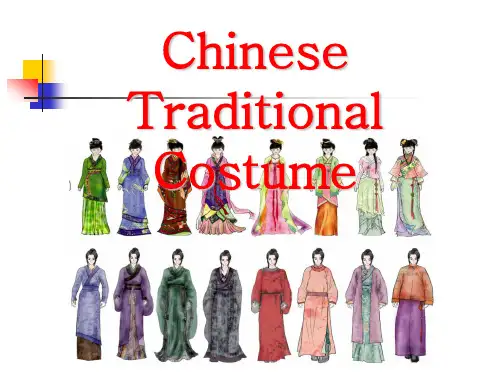
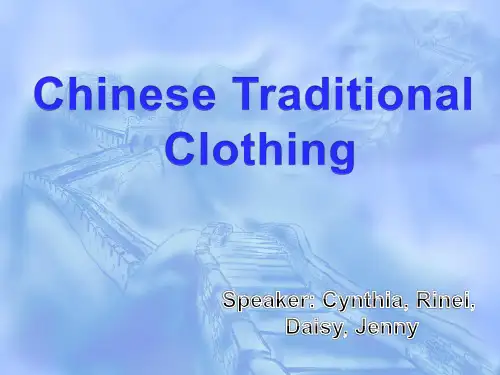
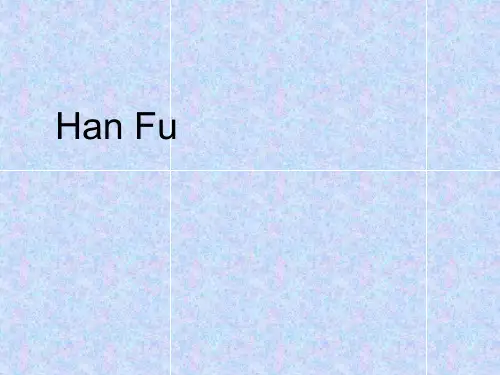
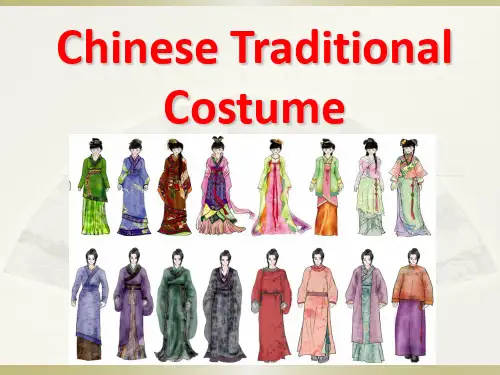
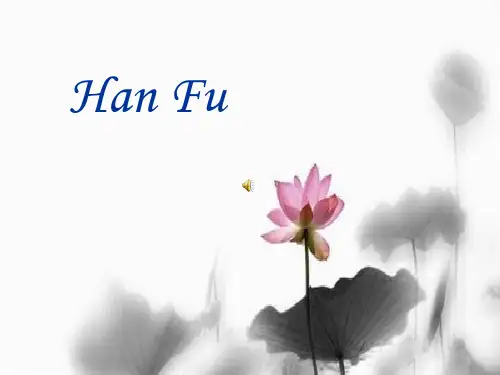
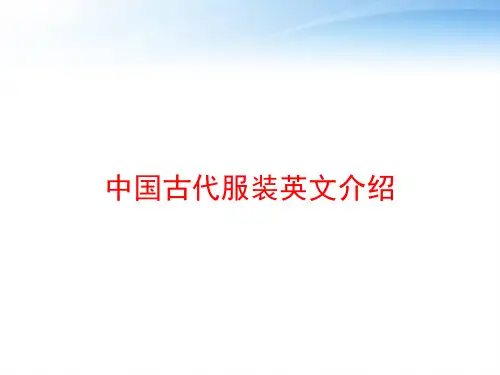
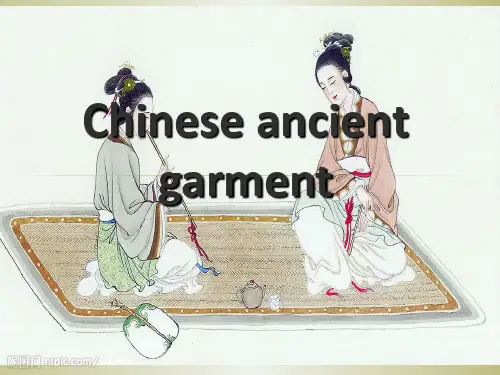
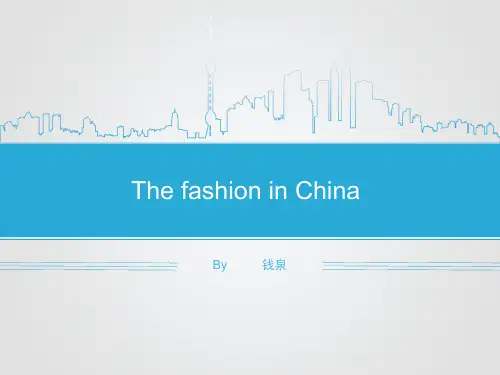

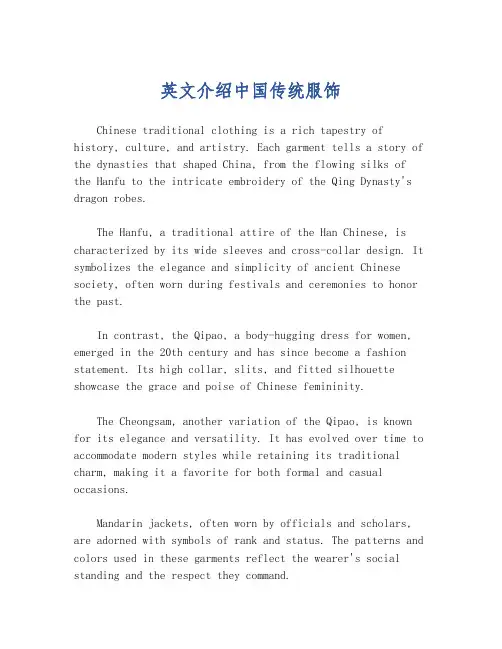
英文介绍中国传统服饰Chinese traditional clothing is a rich tapestry of history, culture, and artistry. Each garment tells a story of the dynasties that shaped China, from the flowing silks of the Hanfu to the intricate embroidery of the Qing Dynasty's dragon robes.The Hanfu, a traditional attire of the Han Chinese, is characterized by its wide sleeves and cross-collar design. It symbolizes the elegance and simplicity of ancient Chinese society, often worn during festivals and ceremonies to honor the past.In contrast, the Qipao, a body-hugging dress for women, emerged in the 20th century and has since become a fashion statement. Its high collar, slits, and fitted silhouette showcase the grace and poise of Chinese femininity.The Cheongsam, another variation of the Qipao, is known for its elegance and versatility. It has evolved over time to accommodate modern styles while retaining its traditional charm, making it a favorite for both formal and casual occasions.Mandarin jackets, often worn by officials and scholars, are adorned with symbols of rank and status. The patterns and colors used in these garments reflect the wearer's social standing and the respect they command.The Zhongshan suit, a modern adaptation of traditional attire, is named after Sun Yat-sen, the founding father of modern China. It combines elements of Western and Chinese fashion, symbolizing unity and progress.Accessories such as the Ruyi, a jade scepter, and the fan, a symbol of refinement, were integral to traditional Chinese attire. They not only served practical purposes but also conveyed social messages.In conclusion, Chinese traditional clothing is more than just garments; it's a reflection of the nation's soul, aliving testament to the rich heritage that continues toinspire and influence fashion today.。
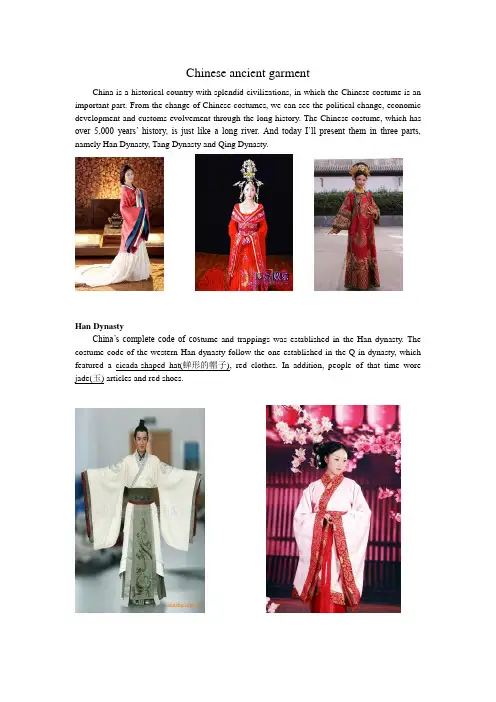
Chinese ancient garmentChina is a historical country with splendid civilizations, in which the Chinese costume is an important part. From the change of Chinese costumes, we can see the political change, economic development and customs evolvement through the long history. The Chinese costume, which has over 5,000 years’ history, is just like a long river. And today I’ll present them in three parts, namely Han Dynasty, Tang Dynasty and Qing Dynasty.Han DynastyChina’s complete code of cos tume and trappings was established in the Han dynasty. The costume code of the western Han dynasty follow the one established in the Q in dynasty, which featured a cicada-shaped hat(蝉形的帽子), red clothes. In addition, people of that time wore jade(玉) articles and red shoes.Tang DynastyFrom the Sui to the Tang, the ancient Chinese clothing developed to its peak. The political stability, economic development, manufacturing and textile technology, and the frequent foreign relations contributed to the development of clothing. The clothing in this period had formed the most fantastic chapter in the clothing history.bold, colorful, various stylesQing DynastyDuring the Qing Dynasty, clothes were elegant and poised. People at that time wore clothes befitting their social status, official ranks and lifestyle according to the regulations of the Qing government. As Manchu is the minority in power of Qing dynasty, the Qing clothing shows a strong nomadic characteristics.shirt is not exposed(衫不露外)the right-side lapel of junction decoratedwith buttons(偏襟右衽以盘纽为饰)clothing plus clothing(衣外加衣)increase waistcoat or jacket (增加坎肩或马褂)Rectangular outline (外轮廓呈长方形)clothes do not get the waist downflowerpot shoes(花盆鞋) (衣服上下不取腰身)Horseshoe-shaped sleeve cover hand(马蹄袖盖手)set rolling craft decoration(镶滚工艺装饰)Nowadays, many people love our traditional culture and worship(尊崇)our ancestry’s clothes style .For this reason they wear Han Clothes, found Han Clothes clubs, hold activities on Han Clothes and so on.1.Wearing Han Clothes to sacrifice (祭祀).2.Wearing Han Clothes to celebrate to be an adult.3.Holding Han Clothes wedding .。
Chinese ancient garment
China is a historical country with splendid civilizations, in which the Chinese costume is an important part. From the change of Chinese costumes, we can see the political change, economic development and customs evolvement through the long history. The Chinese costume, which has over 5,000 years’ history, is just like a long river. And today I’ll present them in three parts, namely Han Dynasty, Tang Dynasty and Qing Dynasty.
Han Dynasty
China’s complete code of costume and trappings was established in the Han dynasty. The costume code of the western Han dynasty follow the one established in the Q in dynasty, which featured a cicada-shaped hat(蝉形的帽子), red clothes. In addition, people of that time wore jade(玉) articles and red shoes.
Tang Dynasty
From the Sui to the T ang, the ancient Chinese clothing developed to its peak. The political stability, economic development, manufacturing and textile technology, and the frequent foreign relations contributed to the development of clothing. The clothing in this period had formed the most fantastic chapter in the clothing history.
bold, colorful, various styles
Qing Dynasty
During the Qing Dynasty, clothes were elegant and poised. People at that time wore clothes befitting their social status, official ranks and lifestyle according to the regulations of the Qing government. As Manchu is the minority in power of Qing dynasty, the Qing clothing shows a strong nomadic characteristics.
shirt is not exposed
(衫不露外)
the right-side lapel of junction decorated with buttons (偏襟右衽以盘纽为饰) clothing plus clothing
(衣外加衣)
increase waistcoat or jacket
(增加坎肩或马褂)
Rectangular outline
(外轮廓呈长方形)
clothes do not get the waist down
(衣服上下不取腰身)
Horseshoe-shaped sleeve cover hand
(马蹄袖盖手)
set rolling craft decoration
(镶滚工艺装饰)
flowerpot shoes(花盆鞋)
Nowadays, many people love our traditional culture and worship(尊崇)our ancestry’s clothes style .For this reason they wear Han Clothes, found Han Clothes clubs, hold activities on Han Clothes and so on.
1.Wearing Han Clothes to sacrifice (祭祀).
2.Wearing Han Clothes to celebrate to be an adult.
3.Holding Han Clothes wedding .
THANKS !!!
致力为企业和个人提供合同协议,策划案计划书,学习课件等等
打造全网一站式需求
欢迎您的下载,资料仅供参考。